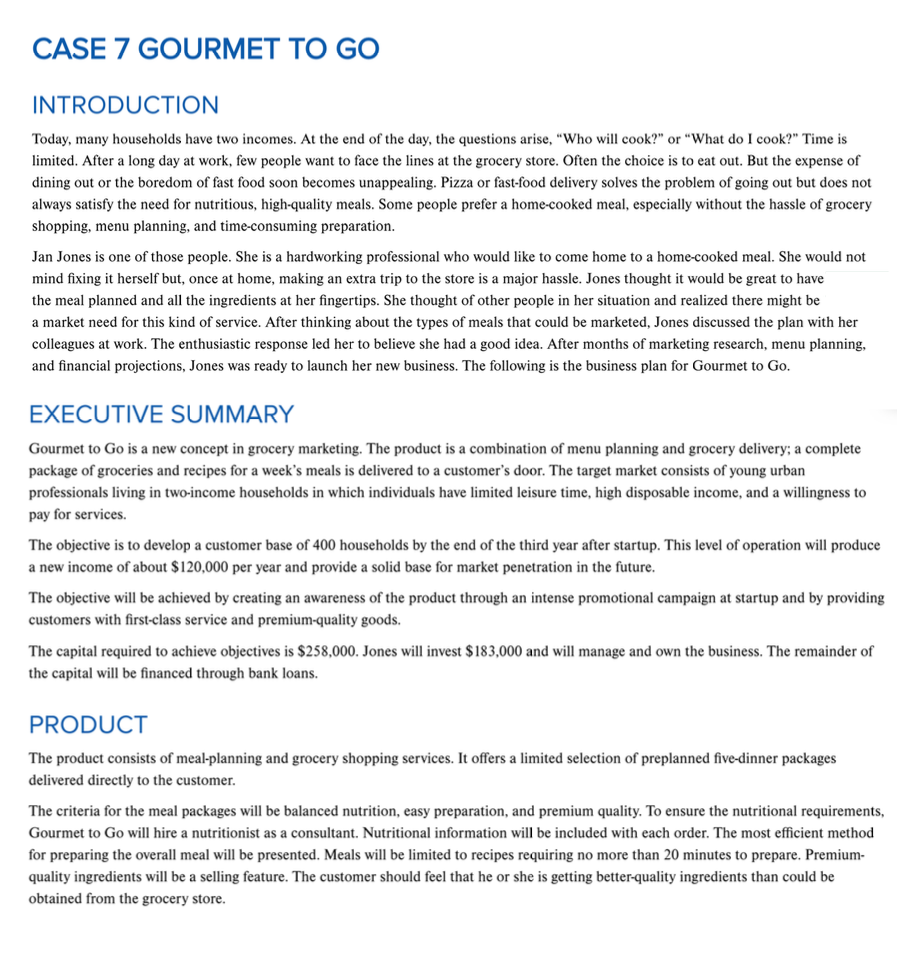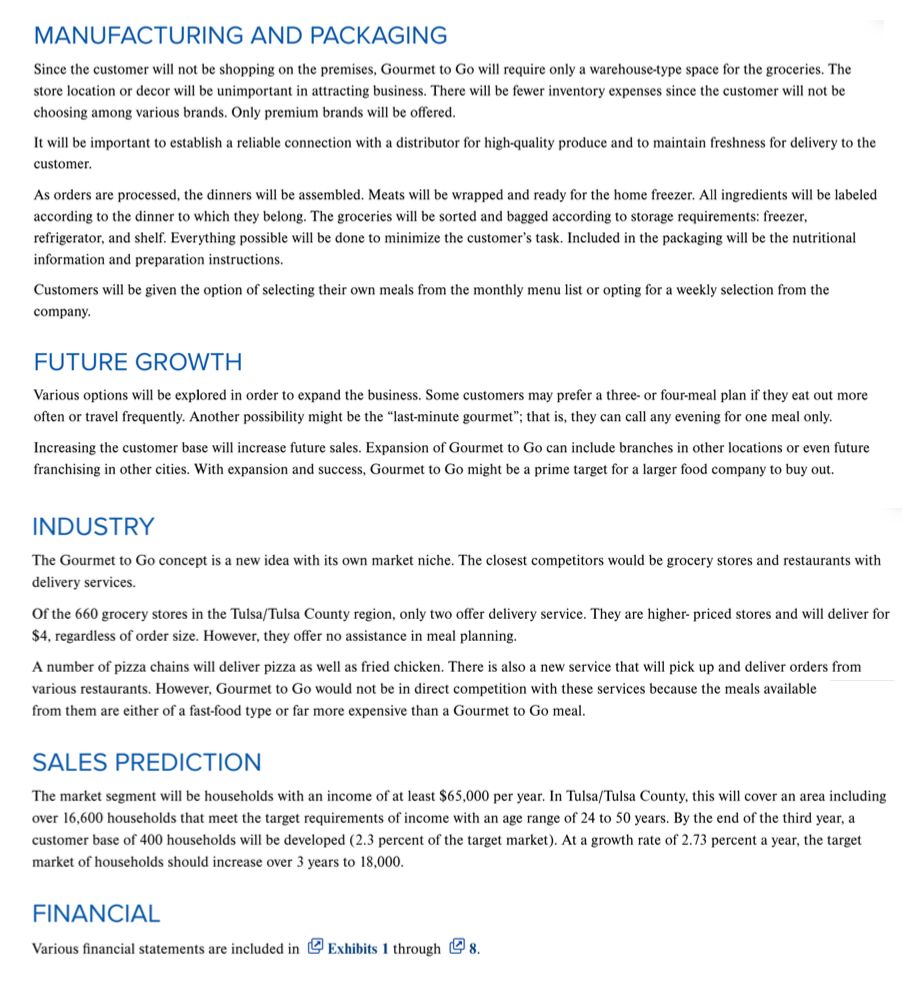Analyze financial projections for startup expenses and capital equipment.


INTRODUCTION Today, many households have two incomes. At the end of the day, the questions arise, "Who will cook?" or "What do I cook?" Time is limited. After a long day at work, few people want to face the lines at the grocery store. Often the choice is to eat out. But the expense of dining out or the boredom of fast food soon becomes unappealing. Pizza or fast-food delivery solves the problem of going out but does not always satisfy the need for nutritious, high-quality meals. Some people prefer a home-cooked meal, especially without the hassle of grocery shopping, menu planning, and time-consuming preparation. Jan Jones is one of those people. She is a hardworking professional who would like to come home to a home-cooked meal. She would not mind fixing it herself but, once at home, making an extra trip to the store is a major hassle. Jones thought it would be great to have the meal planned and all the ingredients at her fingertips. She thought of other people in her situation and realized there might be a market need for this kind of service. After thinking about the types of meals that could be marketed, Jones discussed the plan with her colleagues at work. The enthusiastic response led her to believe she had a good idea. After months of marketing research, menu planning, and financial projections, Jones was ready to launch her new business. The following is the business plan for Gourmet to Go. EXECUTIVE SUMMARY Gourmet to Go is a new concept in grocery marketing. The product is a combination of menu planning and grocery delivery; a complete package of groceries and recipes for a week's meals is delivered to a customer's door. The target market consists of young urban professionals living in two-income households in which individuals have limited leisure time, high disposable income, and a willingness to pay for services. The objective is to develop a customer base of 400 households by the end of the third year after startup. This level of operation will produce a new income of about $120,000 per year and provide a solid base for market penetration in the future. The objective will be achieved by creating an awareness of the product through an intense promotional campaign at startup and by providing customers with first-class service and premium-quality goods. The capital required to achieve objectives is $258,000. Jones will invest $183,000 and will manage and own the business. The remainder of the capital will be financed through bank loans. PRODUCT The product consists of meal-planning and grocery shopping services. It offers a limited selection of preplanned five-dinner packages delivered directly to the customer. The criteria for the meal packages will be balanced nutrition, easy preparation, and premium quality. To ensure the nutritional requirements, Gourmet to Go will hire a nutritionist as a consultant. Nutritional information will be included with each order. The most efficient method for preparing the overall meal will be presented. Meals will be limited to recipes requiring no more than 20 minutes to prepare. Premiumquality ingredients will be a selling feature. The customer should feel that he or she is getting better-quality ingredients than could be obtained from the grocery store. MANUFACTURING AND PACKAGING Since the customer will not be shopping on the premises, Gourmet to Go will require only a warehouse-type space for the groceries. The store location or decor will be unimportant in attracting business. There will be fewer inventory expenses since the customer will not be choosing among various brands. Only premium brands will be offered. It will be important to establish a reliable connection with a distributor for high-quality produce and to maintain freshness for delivery to the customer. As orders are processed, the dinners will be assembled. Meats will be wrapped and ready for the home freezer. All ingredients will be labeled according to the dinner to which they belong. The groceries will be sorted and bagged according to storage requirements: freezer, refrigerator, and shelf. Everything possible will be done to minimize the customer's task. Included in the packaging will be the nutritional information and preparation instructions. Customers will be given the option of selecting their own meals from the monthly menu list or opting for a weekly selection from the company. FUTURE GROWTH Various options will be explored in order to expand the business. Some customers may prefer a three- or four-meal plan if they eat out more often or travel frequently. Another possibility might be the "last-minute gourmet"; that is, they can call any evening for one meal only. Increasing the customer base will increase future sales. Expansion of Gourmet to Go can include branches in other locations or even future franchising in other cities. With expansion and success, Gourmet to Go might be a prime target for a larger food company to buy out. INDUSTRY The Gourmet to Go concept is a new idea with its own market niche. The closest competitors would be grocery stores and restaurants with delivery services. Of the 660 grocery stores in the Tulsa/Tulsa County region, only two offer delivery service. They are higher- priced stores and will deliver for $4, regardless of order size. However, they offer no assistance in meal planning. A number of pizza chains will deliver pizza as well as fried chicken. There is also a new service that will pick up and deliver orders from various restaurants. However, Gourmet to Go would not be in direct competition with these services because the meals available from them are either of a fast-food type or far more expensive than a Gourmet to Go meal. SALES PREDICTION The market segment will be households with an income of at least $65,000 per year. In Tulsa/Tulsa County, this will cover an area including over 16,600 households that meet the target requirements of income with an age range of 24 to 50 years. By the end of the third year, a customer base of 400 households will be developed ( 2.3 percent of the target market). At a growth rate of 2.73 percent a year, the target market of households should increase over 3 years to 18,000 . FINANCIAL Various financial statements are included in Exhibits 1 through 8








